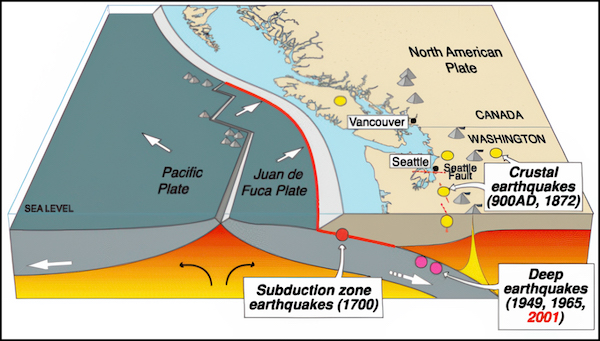Earthquake Risk & Response
-
1What Earthquake Risks Does Vashon Face?We are at risk from three faults under or close to our island
-
2Prepare and Keep InformedSign up for early warnings and know what to do once shaking begins
-
3Vashon's Earthquake Study & HistoryA 2005 study details what severe quakes could bring to Vashon. Looking back at the Nisqually Earthquake in 2001 and its effects.
Vashon has experienced earthquakes in the past, and we will again in the future. Planning is key to saving lives and ensuring a quick recovery during an event when outside help will likely be scarce do to the widespread nature of these incidents. Know the risks, be prepared, and know what to do when the shaking begins and when it stops.

Step 1
Is Vashon at Risk from Earthquakes?
The Tacoma fault zone runs right across Vashon at mid-island. The Seattle fault zone crosses Puget Sound to the north of Vashon at the southern end of Bainbridge Island. These relatively shallow fault systems could generate magnitude 7 quakes, with severe results on Vashon. Because they are so close to Vashon, there might be little warning of a quake stemming from either of these faults.
Geologists used computer models to develop this shake map showing how an earthquake on the Tacoma fault could affect Vashon. You can read the full study here: tinyurl.com/TacomaFaultStudy (U.S. Geological Survey USGS, 2010).
Cascadia: The Big One

The Cascadia fault runs for 600 miles off the coast of northern California, Oregon, Washington, and British Columbia. In 1700, a Cascadia event caused one of the strongest-known earthquakes and tsunamis, a magnitude 9 catastrophe that generated a tsunami wave that caused damage across the Pacific in Japan. Experts think of Cascadia as the “Big One.”
Although a Cascadia event could generate a much stronger quake than the Tacoma or Seattle faults, the Cascadia subduction zone sits off the coast about 170 miles from us. That means the energy from Cascadia shaking would dissipate somewhat by the time it reached Vashon. U.S. Geological Survey (USGS) shake maps produced in recent years estimate a magnitude 9 Cascadia event would feel like a magnitude 7 quake by the time the shaking reached Vashon. However, the shaking from a Cascadia event could last for several minutes, thus increasing potential earthquake damage.

Step 2
Keep Informed & Know What To Do
Earthquake Early Warning
You can set up your smartphone to give you early warning that a quake is happening. The ShakeAlert app was developed by the USGS and it may give you valuable seconds of advance notice to Drop, Cover, and Hold On. VashonBePrepared urges everyone to install the app.
You can read more about it here: www.shakealert.org
Drop! Cover! Hold On!
When you feel shaking, experts say you can help protect yourself from injury with the drop, cover, and hold on tactic.
 DROP where you are, onto your hands and knees. This position protects you from being knocked down and reduces your chances of being hit by falling or flying objects.
DROP where you are, onto your hands and knees. This position protects you from being knocked down and reduces your chances of being hit by falling or flying objects.
COVER your head and neck with one arm and hand. If a sturdy table or desk is nearby, crawl underneath for shelter. If no shelter is nearby, crawl next to an interior wall. Stay on your knees; bend over to protect vital organs.
HOLD ON until the shaking stops. Under a table or other shelter: hold on with one hand; be ready to move with your shelter if it shifts. No shelter: hold on to your head and neck with both arms and hands.
Experts have studied some common misunderstandings about what to do when shaking starts. They tell us what you should not do:
- DO NOT get in a doorway. Better to get under a table to protect yourself.
- DO NOT run outside. The earth is moving, and you could fall or be injured by falling debris or broken glass.
- DO NOT believe the so-called “triangle of life” Internet hoax. It’s just not true.
You can get more information from the Great American Shakeout pages: shakeout.org/dropcoverholdon. You can watch a Drop, Cover, and Hold On video on YouTube: tinyurl.com/DropCoverHoldVideo

Damage on Vashon after an earthquake
Step 3
Earthquakes on Vashon
Vashon Earthquake Damage Study
VashonBePrepared worked with top earthquake experts on a Vashon-specific study of what could happen here from a magnitude 7 earthquake to assist with planning and preparation. The 2005 study utilized sophisticated computer modeling techniques and was managed by geologists, disaster planning specialists, and VashonBePrepared volunteers. The study examines a range of possible effects from four earthquake scenarios. We provide a thumbnail sketch here, and you can read the full text of the study here: tinyurl.com/VashonEQStudy
Casualties and Damage
From the study, estimates showed, as many as 70 people on Vashon would require some degree of medical treatment, with as many as ten people critically injured or killed by the most severe of the four studied earthquake scenarios.
About 100 to as many as 250 Vashon buildings would be so severely damaged that they would be uninhabitable. That’s 2% to 5% of all Vashon buildings. Unreinforced masonry buildings are more susceptible than wood-frame buildings.
Between 600 and 1,100 Vashon buildings would be moderately damaged or worse, requiring extensive repairs or completely destroyed – 22% of all Vashon buildings.
Depending on the scenario, direct economic losses would be at least $41.2 million (2005 estimate). Potentially, losses could reach nearly $83 million.
Food and Shelter
In the immediate aftermath of a daytime earthquake, the Island would need to find shelter for a total of 640 to 1,300 people, including those rendered homeless by destruction of their homes and mainland residents stranded on the island by loss of ferry service.
People in shelters would require between 1,920 and 3,900 meals per day, a total of between 13,000 and 27,000 meals during the first week after the earthquake.
If ferry service was out for more than a week, food needs would quickly soar as grocery stores and home pantries were depleted. Assuming a two-week ferry outage, the Island could require as many as 235,000 emergency meals to feed those in shelters as well as the Island’s own population.

Beachcomber photos courtesy of Vashon Heritage Museum. Photographers Allison Arthur, Rik Forschmiedt, Eric Horsting
2001: The Nisqually Earthquake
At 10:54 am, February 28th, 2001, the Nisqually earthquake struck. Shaking lasted almost one minute. The magnitude was 6.8, and the Mercalli intensity was VIII (Severe) – meaning people would find it difficult to stand and very heavy furniture would be shifted.
Fortunately, damage on Vashon was not severe, compared to other Puget Sound locations where many unreinforced masonry buildings ruptured. The control tower at SeaTac airport was heavily damaged, as was the capitol dome in Olympia. An estimated 400 people were injured and damage totaled more than $2 billion.
The Beachcomber newspaper covered the quake in detail back in 2001. Clockwise from top left: Chautauqua Elementary third graders evacuated to a play area and were comforted by teacher Loren Hill. The road down to Gold Beach ruptured. Engineer Art Rack inspected foundations. Ceramics shop owner Nancy Winebrenner picked up the pieces.
